Posts Tagged ‘Error Coin’
Have I found a rare coin? £2 ‘errors’ explained!
So you’ve noticed something’s not quite right with the £2 coin you’ve just found in your change. A quick google search of the strange variation you’ve noticed brings up a plethora of eBay listings and news articles claiming that you’ve just hit the jackpot and your ‘error’ coin is worth a small fortune!
Sadly, in this instance Google is not your friend and whilst genuine errors are out there, so too are a number of common mis-strikes and myths, or even fakes that have been manipulated to look like an error.
So what is the difference between a mis-strike and an error I hear you ask.
Put simply, a true error is caused by human mistake, such as the wrong die or metal being used to strike a coin, whereas a mis-strike is created by the mass production process, as hundreds of thousands of coins are struck, meaning variations are bound to occur, especially when dies and machinery become worn.
But which mis-strikes on the bi-metallic £2 coin should you be aware of?
I recently read Scott Wren’s article, ‘Bi-metallic “errors”… Why two is better than one’ published in Coin News which highlights some of the mis-strikes found on £2 coins and how their bi-metallic quality causes the differences to be something entirely more spectacular than those found on monometallic (single metal) coins.
Striking bi-metallic coins
In order to understand why mis-strikes on bi-metallic coins are often more pronounced than monometallic coins, it’s first a good idea to look into how these coins are produced.
When striking £2 coins, the first step is to punch a hole through a blank planchet to create the outer section. The inner core is taken from a different metal, sized to fit inside the outer ring.
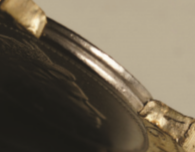
A groove is milled around the edge of the inner core so that when both parts are struck together, the metals will fuse as the outer ring deforms and spread into the groove, locking it into place.
Now that we know how £2 coins are struck, here are some of the mis-strikes and errors that can occur in the process…
The following images of variations found on £2 coins have been taken from Coin News for use in this blog.
Clipped Planchet
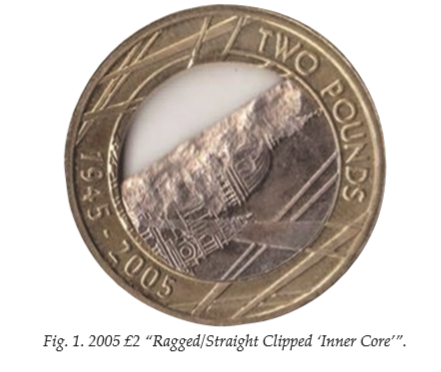
Figure 1 shows how the inner core was punched out from the end of the sheet of metal used for blanks, forming a straight or ragged edge clip.
Whilst this also occurs with monometallic coins, the pairing with an outer ring exposes a large gap which is much more noticeable.
The Royal Mint strike millions of coins each year so it is inevitable that variances will occur during the striking process and can’t always be picked up during quality control, despite the fact that this particular coin would weigh less than the standard 12g £2 coin. However, a small quantity of coins do sometimes manage to slip through the net and as i’m sure you’ll agree, they make for interesting collecting.
But before you pay over the odds for one of these coins, beware of fakers! Some coins are manipulated to look like mis-strikes or error coins and sold to unsuspecting buyers. Check the clipped planchet edge of the coin to see if it’s genuine by making sure the detail of the design fades away towards the edge rather than suddenly stopping, which would indicate the coin had been cut.
Off Centre Inner Core
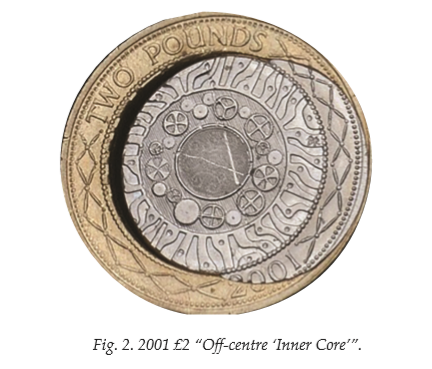
Figure 2 shows an inner core which hasn’t been united properly prior to being struck.
Due to the way the inner and outer core are struck together with the two metals being lined up and then fused together during striking, a misalignment will mean that the inner core spills into the outer ring, as seen in the image above. There might also be a gap between the two metals on the opposing join.
This mis-strike is thought to be fairly common on the bi-metallic 12 sided £1 coin as well as some of the Technology £2 coins and even foreign bimetallic coins, but have you ever spotted one in your change?
Faulty Outer Ring
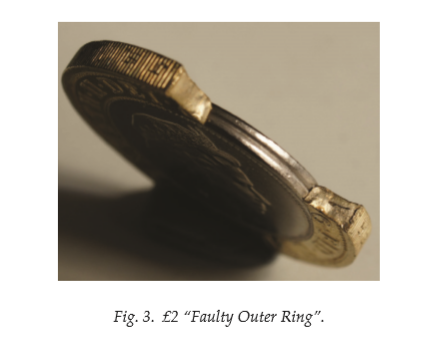
Figure 3 shows a faulty planchet or outer ring, where the inner core is exposed.
In the image above, you can actually see the specific engineering design features where the inner core is grooved to help the metal flow bond to the outer ring and fuse during striking.
Similar to the first mis-strike we looked at, this could be caused by a clipped planchet, this time created when the outer ring was punched, however coins like this may also be caused by tampering post striking, for example by fakers trying to replace the inner core of a £2 with another coin to pass off as a rare error.
The Holy Grail of Bi-metallic ‘Errors’
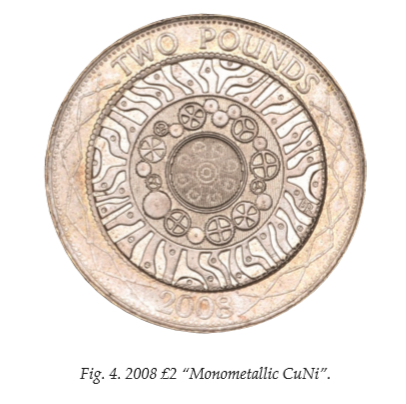
Figure 4 is described as the Holy Grail of bimetallic ‘errors’ and is the result of the nickel-brass £2 blank not having the inner core section punched out before being struck.
This means that the £2 coin is made from one full piece of nickel-brass, completely contrasting the very idea of a bimetallic coin.
A 2007 monometallic £2 was verified by The Royal Mint and in the email confirming the mis-strike it was mentioned that they had only seen 4-5 similar coins before.
This rare striking error is highly sought after and coins have achieved extraordinary prices in private sales and auctions.
Foreign Planchet
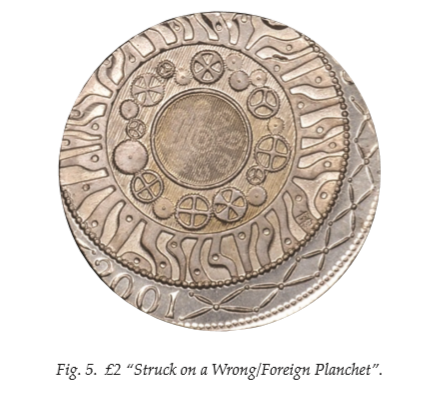
Finally, figure 5 shows a £2 design struck on the wrong planchet – a blank normally used to strike a different coin.
As The Royal Mint strikes a huge quantity of coins for different denominations and even different countries, blanks can sometimes end up in the wrong striking chamber, creating a wrong or foreign planchet error.
This is actually down to human error rather than a mis-strike and the coins would normally be picked out during quality control, however some have been spotted in circulation, not only on the £2 coin, but on various different denominations across UK coins and world wide.
One of the most famous examples in the UK is the silver 2p – a 2p coin struck on to a 10p blank which sold for 67,580 times its face value at auction.
Other £2 ‘errors’ that are worth keeping your eyes peeled for!
2014 First World War (Lord Kitchener) £2 – Two Pounds ‘Error’

This £2 coin was issued in 2014 to mark 100 years since the outbreak of the First World War. It features an image of Lord Kitchener who was a prominent figure on British government propaganda campaigns during the time.
5,720,000 of these coins entered circulation, meaning it could be quite easy to stumble across one in your change. However, a small number of these coins are supposed to have entered circulation without the ‘Two Pounds’ denomination on the obverse.
Sometimes the denomination of the coin will feature on the reverse design, meaning it won’t appear on the obverse too. This can be seen on the Trinity House £2 coin which was issued earlier in the same year as the First World War £2.
It’s possible that the dies used to strike the obverse of the Trinity House £2 coin wasn’t replaced when the production of the First World War Centenary £2 coins began, resulting in the absence of a denomination.
We’ve only heard of two reports of these ‘error’ coins being found in circulation. However, Lockdales Auctioneers officiated the sale of the very first one back in March 2020 to the value of £500! A hefty return on a £2 coin…
Have you ever seen this £2 ‘error’? We’d love to know in the comments below.
So how much is my ‘error’ coin worth?
These mis-strikes and errors certainly make for interesting collecting and the rarer variations, such as monometallic £2 coins could certainly sell for over face value.
In fact, one such monometallic mis-strike found on a 2007 Technology £2 is estimated to be worth over £1,000!
Ultimately, as with all coins, it’s all down to how much an individual collector is willing to pay to add that coin to their collection.
If you’ve found a £2 coin with a mis-strike, it’s certainly worth having it verified and authenticated by The Royal Mint, who will supply a letter detailing their findings.
So have you found any interesting variations on your bimetallic £2 coins? Let us know in the comments below!
With thanks to Scott Wren from Coin News.
If you’re interested in coin collecting, our Change Checker web app is completely free to use and allows users to:
– Find and identify the coins in their pocket
– Collect and track the coins they have
– Swap their spare coins with other Change Checkers
Sign up today at: www.changechecker.org/app
Why you should be collecting £2 coins
With some truly fantastic releases recently, the UK has fallen head over heels for the 50p, with many collectors focusing on hunting down these seven sided gems for their collection.
But whilst collectors are busy scouring their change to find the latest and greatest 50p releases, the £2 coin, it seems, has taken a bit of a back seat…
So why should you be collecting £2 coins?
In this blog, we’ll take a look at which rare coins should take pride of place in your collection, which potential error coins might be out there and we’ll also share with you our top three £2 coins to look out for.
Rare and Error Coins
With over 37 different UK £2 coin designs in circulation, it’s worth paying attention to the £2 coins in your change, as you never know when you might come across something extra special…
2002 Commonwealth Games NI £2
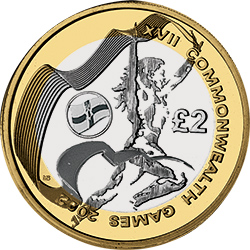
The 2002 Commonwealth Games England £2 Coin is officially the most scarce £2 coin in the UK, ranking as 100 on our Scarcity Index.
Four coins were released in 2002 to celebrate the Commonwealth Games and at first glance, you might struggle to spot the difference between them. They all feature the same running athlete trailing a banner behind. But each has a different cameo, representing each of the four constituent parts of the United Kingdom.
The fact that this coin is so hard to spot and has such a low mintage of just 485,500 means that the Commonwealth Games NI £2 is the holy grail of £2 coin collections.
2015 Britannia £2

It wasn’t until 2016, when The Mint released the mintage figures for the 2015 coins, that collectors realised just how special the new definitive £2 coin was.
Only 650,000 of the 2015 date Britannia £2 coins had been stuck for circulation, making it one of the most scarce UK £2 coins ever issued! So scarce in fact that there were fewer of this coin than the England and the Scotland coins from the famous 2002 Commonwealth Games series.
This makes the 2015 Britannia £2 joint third scarcest £2 coin in circulation, alongside the Navy £2.
Inverted Effigy Britannia £2

First discovered by a Change Checker, and later confirmed as a genuine error by The Royal Mint, this unusual strike appears on a handful of the 2015 Britannia £2 Coins.
The Royal Mint has accounted for the seemingly impossible misalignment of the Queen’s effigy as “almost certainly the result of one of the dies working loose and rotating during the striking process”.
The result is that the Queen’s head is offset by around 150 degrees compared to the Britannia design on the reverse of the coin.
We analysed 5,000 circulation Britannia £2 coins and our results suggested that the Inverted Effigy may have affected as few as 1 in 200 of the coins struck – in other words around just 3,250 coins.
2015 Navy with Flag

We already know the 2015 Navy is one of the rarest £2 coins with just 650,000 struck for circulation, however Change Checkers have speculated whether there are two different design variations…
The original Navy £2 design (left) shows the coin without any markings on the top right of the mast, but the coin on the right looks like it has a flying flag.
The Royal Mint strike up to 5 billion coins a year and from time to time cracks on the die cause pools of metal to form on the coin whilst striking. It just so happens that this bit of metal has caused the markings on these coins to look like a flying flag on the ship – fuelling speculation that two different variations were struck.
Whilst it doesn’t add any extra value to the coin, it’s certainly one to look out for and makes for interesting collecting.
2005 ‘Pemember, Pemember’ Gunpowder Plot £2
The 2005 Gunpowder Plot £2 commemorates the 400th anniversary of Guy Fawkes’ failed assassination attempt on King James I, but the coin is more familiar to collectors for having a spelling mistake in the edge inscription. The timeless quote “Remember, remember the fifth of November” has been found with various combinations of Pemember, Pemembep, Novemebep and so on. The common factor here is the ‘R’ which appears as a ‘P’.
Sadly for collectors this is apparently not a striking error. The explanation from the Royal Mint is that the down-stroke of the R coincides with the milling around the edge, and as the coin has worn over time, the letter has become less defined. This categorical statement from the Mint means that any mark-up in price for a supposed ‘error’ is completely unjustified, and although it makes the coin more interesting, it is not the mistake which it is often perceived to be.
1997 Maklouf ‘Queen with a Necklace’ £2
The ‘Queen with a Necklace’ £2 has an enduring legacy in the collecting world. The very first bi-metallic £2 coins were issued in 1997, just prior to the Queen’s portrait change in 1998. This meant that the older portrait by Raphael Maklouf was only used for one year: 1997. His version featured Queen Elizabeth II wearing a necklace, which is how the nickname was derived.
When the portrait change was announced, the new £2 coins were snapped up by collectors believing them to be a future rarity. As it turned out, a mintage of nearly 14 million means the ‘Queen with a Necklace’ £2 is not one of the rarest coins in circulation. Nevertheless, with only one year of issue, it still holds an undeniable interest for collectors.
2007 Abolition of Slavery £2
There is a misconception that there were two types of the Abolition of Slavery £2 coin struck for circulation. It is true that two versions of the coins exist – one has a textured finish whereas the other has a smooth finish and features the artist, David Gentleman’s initials (circled).
The key difference is that only the textured version was struck for circulation, and if you find one of the smoother types in your change, you have actually found a coin which has been taken out of a presentation pack. This makes it considerably rarer than the circulating version, so it is worth keeping rather than spending!
The Top Three £2 Coins to Collect
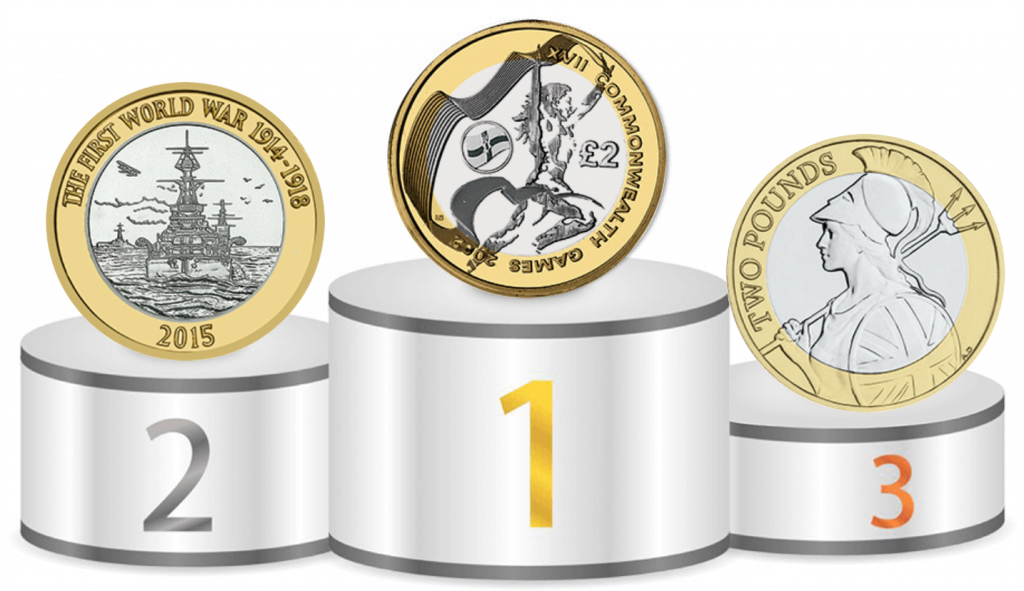
When it comes to collecting, £2 coins are some of our favourites to look out for, but out of the rare and wonderful coins mentioned above, here are our top three £2 coins to collect.
1) It’s no surprise that the UK’s scarcest £2 coin in circulation should come in first place, but you’ll not only have to be very lucky to come across one, you’ll also have to be eagle eyed to spot the correct flag for the Commonwealth Games Northern Ireland £2 coin.
2) Coming in close second is the third scarcest £2 coin, but can you challenge yourself to see if you can find one with the ‘flag’ variation as mentioned above?
3) And as our third placed coin, the 2015 Britannia actually sits in joint third place as the UK’s scarcest £2 in circulation and our challenge to you is to try and find the inverted effigy of this coin too!
Check out how we got on with our own £2 coin hunt and all the fantastic designs we were able to find in a £500 bank bag:
The £2 coins that haven’t entered circulation…
You may have noticed a lack of 2017 coins in your change, as to date The Royal Mint haven’t confirmed if they will enter circulation.
This all depends on demand for specific denominations at the time as UK Banks and Post Offices may not request every denomination every year if there is already sufficient coin in circulation.
Based on The Royal Mint’s figures, we do know that no 2017 Britannia coins were struck for circulation. But there have been 13 other coins designs issued since 2017 that we are yet to find in our change, including:
- Jane Austen
- WW1 Aviation
- Frankenstein
- Armistice
- RAF Badge
- RAF Spitfire
- RAF Vulcan
- RAF Sea King
- RAF Lightning
- Captain Cook
- Samuel Pepys
- D-Day Landings
- Wedgwood
All of these coins are available to purchase in Brilliant Uncirculated quality here, but we will of course be the first to update you as soon as we have more information on their potential release.
A Treasure Hunt
It can be quite a challenge tracking down every single £2 coin for a complete collection. Remember, if you’re struggling to find those last few coins in your change, you can source them online, in auctions, on Facebook coin groups and of course by swapping with like-minded collectors on our web app.
If you’re interested in coin collecting, our Change Checker web app is completely free to use and allows users to:
– Find and identify the coins in their pocket
– Collect and track the coins they have
– Swap their spare coins with other Change Checkers
Sign up today at: www.changechecker.org/app
How much is your coin really worth? Debunking eBay coin price myths…
When it comes to coin collecting, whilst the thrill is in the find, it really is the icing on the cake when you manage to find a particularly rare coin which is worth more than its face value. However, all too often we are bombarded by press articles citing eBay listings of ‘rare’ or ‘error’ coins and, naturally, our interest is piqued when we hear about the coin we’ve just come across in our change ‘selling for thousands’.
Unfortunately though, these articles can often sensationalise the actual value of the coin and when taken out of context we can forget that anyone can list anything they like on eBay, for whatever price they choose, regardless of whether or not the item is genuinely worth it.
So to help you avoid the pitfalls of buying coins eBay, we’ve created our top 5 eBay buying tips at the bottom of this blog.

When a coin is listed for excessive amounts it draws attention to itself and all it takes is for the press to pick up on it for more people to start believing that the coin really is valuable and so the story grows. But in reality, these coins are not usually worth the price they are listed for and are very unlikely to actually sell. Even if the coin does sell at that price, there is no guarantee that the sale will actually go through.
How much is my Benjamin Britten 50p worth?
We’ve seen this time and again, particularly for the 2013 Benjamin Britten 50p. In fact one of the most regular questions we get at Change Checker is: “I have a Benjamin Britten 50p – how much is it worth?“.
There’s no doubt that the Benjamin Britten 50p was somewhat overlooked when it was first released and it is amongst the slightly more scarce coins in circulation, but ask yourself this… would you pay £800 for one?
Whilst a brilliant uncirculated quality Benjamin Britten 50p might sell for around £10, you’re likely to come across a circulation quality coin in your change, as this 50p has a mintage figure of 5,300,000 and is ranked as common on our scarcity index.
Read our blog ‘So i thought my coin was worth £800…’ for more information.
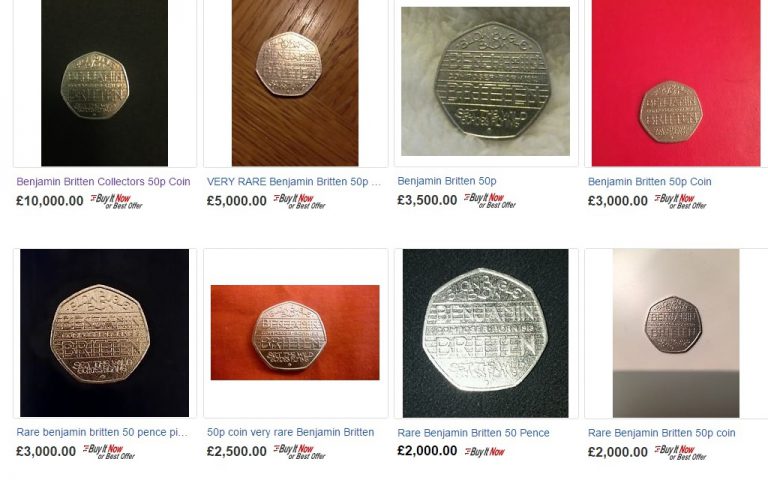
But it’s not just Benjamin Britten – there are others… including the 2005 Gunpowder Plot ‘Pemember’ £2 and the 2012 Charles Dickens ‘error coin’, as well as the new coin releases such as the leaked Paddington 50p…
Gunpowder Plot £2 ‘error’
The 2005 Gunpowder Plot £2 commemorates the 400th anniversary of Guy Fawkes’ failed assassination attempt on King James I, but the coin is more familiar to collectors for having a spelling mistake in the edge inscription. The timeless quote “Remember, remember the fifth of November” has been found with various combinations of Pemember, Pemembep, Novemebep and so on. The common factor here is the ‘R’ which appears as a ‘P’.
Sadly for collectors this is apparently not a striking error. The explanation from the Royal Mint is that the down-stroke of the R coincides with the milling around the edge, and as the coin has worn over time, the letter has become less defined. This categorical statement from the Mint means that any mark-up in price for a supposed ‘error’ is completely unjustified, and although it makes the coin more interesting, it is not the mistake which it is often perceived to be.

Charles Dickens £2 ‘error’
The Charles Dickens £2 coin was issued by The Royal Mint in 2012 to commemorate the 200th anniversary of one of Britain’s most famous and beloved writers. The design features Dickens’ recognisable profile crafted from the titles of his most famous works and is a favourite amongst collectors.
But recently, a number of stories have been popping up regarding the ‘errors’ people have noticed, such as fading dots around the centre part, upside down edge lettering and misspelling of the edge inscription. Unfortunately these aren’t errors, but are simply caused by the mass production process, the way obverses and reverses are struck and how the coin has worn down in circulation.

Paddington 50p leaked coins
The Paddington 50p coins were issued by The Royal Mint to celebrate the 60th anniversary of Michael Bond’s novel, “A Bear Called Paddington” and were some of the most sought-after coins of 2018, which is why collectors were particularly excited when some of the coins were discovered a few days before the official release…
The coins quickly made their way onto collectors’ forums and eBay, with one attracting a “sold price” of £16,000 – prompting interest from a number of national newspapers.
It’s highly unlikely that the transaction actually went through, and as the official launch date was just a few days later, we urged collectors to wait to be able to purchase the coin for just £3.99 instead.

We would always suggest caution and user discretion when buying and selling on eBay. To get a more realistic idea of what your coin could potentially sell for, view the ‘sold listings’ on eBay to see the actual prices buyers have been willing to pay, although again there is still no guarantee that these sales have all actually gone through.
Remember – even the rarest of all circulating 50p coins – 1992/93 EU Presidency – was sold by Change Checker for just £20.
So to help you get the most out of your money, we’ve created 5 eBay buying tips:

Tip 1) Check recently sold prices
Whilst coins can be listed on eBay for incredibly high prices, it doesn’t mean they will actually sell at this price. Make sure you search for ‘sold listings’ when researching how much buyers are currently willing to pay to check that your coin is in line with this.
Tip 2) Check if it can still be bought from official Royal Mint distributors
Take a look online at The Royal Mint’s website and on our site to see if the coin can still be bought from an official distributor, as this will affect the price of the coin on the secondary market. Buyers will be willing to pay more for a coin on the secondary market if it is no longer on sale at The Royal Mint.
Tip 3) Check if the coin is real or fake
The only way to know for certain that a coin is real is for it to be x-rayed, however there are some simple checks you can make yourself such as making sure the edge inscription and date matches the design and that the coin condition reflects the amount of time it’s been in circulation. For example, the Kew Gardens 50p has been in circulation for nearly 10 years, so a shiny Kew for sale on eBay is likely to be a fake unless it’s in the original packaging.
Tip 4) Check the coins rarity
Use our mintage charts and Scarcity Index to see how scarce the coin is and check our blogs to see if it has an interesting story that makes the coin more sought-after. Make sure you check for any errors that could add to the coins value, such as the wrong date or metal being used.
Tip 5) Check the coins condition
If the coin is in Brilliant Uncirculated quality it will most likely sell for more than a circulated coin which is more worn. Typically, the more worn the coin is, the less a buyer is likely to be willing to pay.
Remember you can also use our 6 point guide to valuing your coins to help you determine how much your coin might realistically be worth.
Best of luck buying and selling your coins!
If you’re interested in coin collecting, our Change Checker web app is completely free to use and allows users to:
– Find and identify the coins in their pocket
– Collect and track the coins they have
– Swap their spare coins with other Change Checkers
Sign up today at: www.changechecker.org/app





